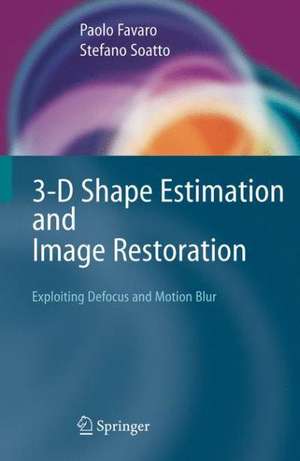3-D Shape Estimation and Image Restoration: Exploiting Defocus and Motion-Blur
Autor Paolo Favaro, Stefano Soattoen Limba Engleză Paperback – 18 feb 2013
| Toate formatele și edițiile | Preț | Express |
|---|---|---|
| Paperback (1) | 415.91 lei 6-8 săpt. | |
| SPRINGER LONDON – 18 feb 2013 | 415.91 lei 6-8 săpt. | |
| Hardback (1) | 423.00 lei 6-8 săpt. | |
| SPRINGER LONDON – 29 dec 2006 | 423.00 lei 6-8 săpt. |
Preț: 415.91 lei
Preț vechi: 519.88 lei
-20% Nou
Puncte Express: 624
Preț estimativ în valută:
79.59€ • 85.10$ • 66.36£
79.59€ • 85.10$ • 66.36£
Carte tipărită la comandă
Livrare economică 17 aprilie-01 mai
Preluare comenzi: 021 569.72.76
Specificații
ISBN-13: 9781849965590
ISBN-10: 1849965595
Pagini: 264
Ilustrații: XIV, 249 p.
Dimensiuni: 155 x 235 x 17 mm
Greutate: 0.37 kg
Ediția:2007
Editura: SPRINGER LONDON
Colecția Springer
Locul publicării:London, United Kingdom
ISBN-10: 1849965595
Pagini: 264
Ilustrații: XIV, 249 p.
Dimensiuni: 155 x 235 x 17 mm
Greutate: 0.37 kg
Ediția:2007
Editura: SPRINGER LONDON
Colecția Springer
Locul publicării:London, United Kingdom
Public țintă
ResearchCuprins
Basic models of image formation.- Some analysis: When can 3-D shape be reconstructed from blurred images?.- Least-squares shape from defocus.- Enforcing positivity: Shape from defocus and image restoration by minimizing I-divergence.- Defocus via diffusion: Modeling and reconstruction.- Dealing with motion: Unifying defocus and motion blur.- Dealing with multiple moving objects.- Dealing with occlusions.- Final remarks.
Recenzii
"This book presents a framework for estimating three-dimensional (3D) shapes from defocused and motion-blurred images. The book systematically describes various problems involved in estimating 3D shapes, and provides solutions to these problems… The book is well-written, and is equipped with Matlab code that implements the estimators presented in the chapters… I recommend this book to engineers in image processing and computer vision. Readers will learn state-of-the-art methods for shape restoration." (Hsun-Hsien Chang, ACM Computing Reviews, Vol. 49 (9), September 2008)
Textul de pe ultima copertă
Images contain information about the spatial properties of the scene they depict. When coupled with suitable assumptions, images can be used to infer three-dimensional information. This useful volume concentrates on motion blur and defocus, which can be exploited to infer the 3-D structure of a scene—as well as its radiance properties—and which in turn can be used to generate novel images with better quality.
3-D Shape Estimation and Image Restoration presents a coherent framework for the analysis and design of algorithms to estimate 3-D shape from defocused and motion blurred images, and to eliminate defocus and motion blur to yield "restored" images. It provides a collection of algorithms that are optimal with respect to the chosen model and estimation criterion.
Topics and Features include:
• Comprehensive introduction to guide readers through the different areas of the topic
• Basic models of image formation
• Discussion of least-squares shape from defocus
• Unifying defocus and motion blur
• Handling multiple moving objects
• Dealing with occlusions
• Appendices supply the necessary background in optimization and regularization
• www.eps.hw.ac.uk/~pf21/FavaroSoattoBook/downloads contains implementations of relevant algorithms, test data and demos.
Written for readers with interests in image processing and computer vision and with backgrounds in engineering, science or mathematics, this highly practical text/reference is accessible to advanced students or those with a degree that includes basic linear algebra and calculus courses. It can also be seen as a resource for practitioners looking to expand their knowledge in the subject.
3-D Shape Estimation and Image Restoration presents a coherent framework for the analysis and design of algorithms to estimate 3-D shape from defocused and motion blurred images, and to eliminate defocus and motion blur to yield "restored" images. It provides a collection of algorithms that are optimal with respect to the chosen model and estimation criterion.
Topics and Features include:
• Comprehensive introduction to guide readers through the different areas of the topic
• Basic models of image formation
• Discussion of least-squares shape from defocus
• Unifying defocus and motion blur
• Handling multiple moving objects
• Dealing with occlusions
• Appendices supply the necessary background in optimization and regularization
• www.eps.hw.ac.uk/~pf21/FavaroSoattoBook/downloads contains implementations of relevant algorithms, test data and demos.
Written for readers with interests in image processing and computer vision and with backgrounds in engineering, science or mathematics, this highly practical text/reference is accessible to advanced students or those with a degree that includes basic linear algebra and calculus courses. It can also be seen as a resource for practitioners looking to expand their knowledge in the subject.
Caracteristici
Describes analytical processes Delineates the options open to programmers Presents original algorithms Demonstrates a coherent analytical framework for the analysis and design of algorithms to estimate 3D shape from defocused and blurred images












